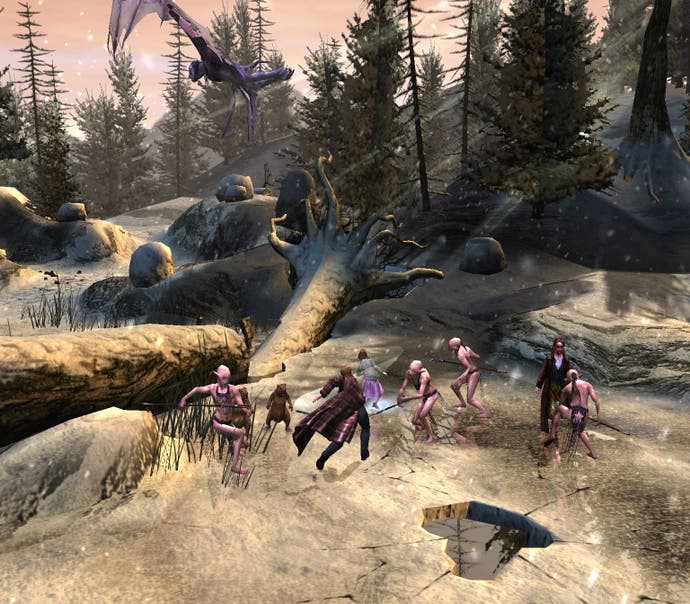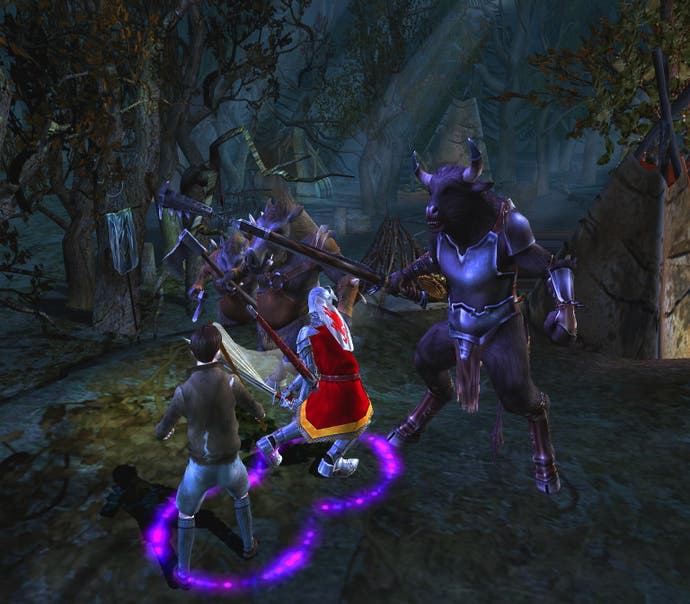The Lion, the Witch, and the Wardrobe
The money, the money, and the more money.
As numbers go, 85 million is "big", especially when that figure is describing book sales. If you're talking about 85 million children's books, you're talking about Potter, right? Only half-right in this instance. [Classic misdirection! - Ed] Specifically, Potter is the only children's book series to ever sell more than this amount, the total sales of CS Lewis's Narnia series. That's an awful lot of books. And if your memory of Peter, Edmund, Susan and Lucy's harrowing adventures in the land of snow and ice has been dismissed to some childish corner of your rapidly deteriorating brain, along with Texan bars and hazy episodes of The Red Hand Gang, you'd best prepare for its inevitable return: Disney's about to release the first tale in the series, "The Lion, the Witch, and the Wardrobe", as a railroading media franchise this Christmas. The movie will be Disney's biggest to date, in terms of marketing spend at least. When it comes to numbers, Narnia's got it all sewn up.
The location for Disney's first post-E3 presentation of The Chronicles of Narnia: The Lion, the Witch, and the Wardrobe - a hotel just outside Manchester in some random small town - is initially incongruous. The facts and figures, however, are far less confusing. The Narnia series, as mentioned, is the second-biggest-selling children's book franchise of all time. The Disney movie hitting this Christmas will be one of the season's heaviest hitters, competing directly with King Kong and the next Potter film for your attention, and that of the nation's children. Toys and other collectibles are soon to be released, as are new versions of all seven books in the series (you can probably see where this is heading), while Disneyland Paris will soon play host to a huge Narnia exhibit, a monstrous McDonald's campaign is planned, cereal box marketing will be kicking off, and so on. In two months time, you're not going to be able to move for Narnia.
The game will be just as high-profile; an all-platform-encompassing release – PC, PS2, Xbox, PSP, DS and GBA all get a crack at the whip – pushed with a huge marketing budget. Disney's employed children's doyenne Traveller's Tales, hot from the creation of LEGO Star Wars, to do the job. Which is why we're sitting in a hotel near Manchester, see: the studio's just down the road.
Witch way now?

We saw Narnia for a brief instant at E3, but getting a decent look at anything on the LA show floor is akin to reading the Mystery Plays in a hurricane. The same demo is shown, but this time we're talked through the specifics of the PS2 and Xbox versions (they're identical) by John Burton, Traveller's Tales director, and Adam Rubins, marketing director from Buena Vista Interactive, the gamey side of Disney, the ultimate media behemoth(TM). What they show us is surprisingly involved for a children's title.
The game, like the film, is based solely on The Lion, the Witch, and the Wardrobe, the first instalment in Lewis's series, published originally in 1950. The first level we see takes place in the Professor's mansion. Peter and Susan, two evacuees from London during the Second World War, are running around the house in the third-person collecting objects, with the player able to switch between characters at any time. Burton tells us that the mansion is based on blueprints from the movie studio, but that certain areas have been expanded for gameplay purposes.
Another player can also take control of the other character by plugging in another pad, and this section of the game, dripping in 40s nostalgia, focuses very much on mini-endeavours such as hiding in chests and crannies from Mrs McCready, the venomous housekeeper. The section looks for all the world like The Philosopher's Stone, but perhaps the comparison isn't fair: it's reasonably difficult to construct any game involving children any more without the word "Potter" instantly being emblazoned on the psyches of the masses.
Before this, we're assured, is a bombing level based on the start in the movie, where the children must survive a German attack on the Capital. From there it's off to their pied-a-terre for the rest of the War and the second level. Direct footage from the movie stitches together the levels, of which there are 15 in total. After running rings around the dopey housekeeper for half an hour, Lucy, the smallest of the children, happens across the wardrobe, a secret door to another world. As you do. From there on it, things get a lot more interesting.
Basic? We'd be lion.

The game is far from complete in the state we see it, so none of the inter-level story-telling is in place, but we're transported through the medium of dev codes to a snowy fantasy land; that of Narnia. It becomes instantly apparent that the mansion was a training level. Peter sets about lighting sticks and using them to melt snow to uncover secrets and other areas (in one example, he burns brush to uncover a log which is then used to breach a chasm) and he's soon up to his elbows in combat with wolves and goblin types. It's worth noting at this point that Narnia really isn't aimed at very young children. Burton tells us privately later that the target age-range is 10 and older.
Suddenly, the game has a completely different feel, more of an action-RPG than anything else. Three characters work as a team during what rapidly becomes incessant combat, with the player flipping between them; AI assuming control of the two left over when a single-player takes charge of one of the trio (another player can, of course, take on one of the other characters). Each of the children has different abilities. Peter is handy with his fists, Susan is more of a projectile weapons specialist (snow balls, bows, and so on), and Lucy's diminutive physical stature means she's able to squeeze through small gaps.
Character combinations are essential to progress. Lucy can jump on Susan's back, and between them they acquire a new skill-set: Susan can then spin, using Lucy as a weapon to defeat more powerful enemies, and Lucy is suddenly able to pass through deep snow. Combinations are possible with all characters.
There's even a basic combo system, whereby you build up combos with hits – the more hits you achieve in a row, the more damage you inflict. Just to round off the Baldur's Gate feel, Lucy acts as the group's healer. You even spend points on new moves between levels. Burton's even talking about "player styles" at this point. For a children's game, this is all looking remarkably adult.
Lots of, er, wardrobes.

But then, anyone who's read the books (which are actually a blatant Christian allegory) will be aware that the Narnia stories are very much at the darker end of children's fiction - something that's not been lost on the game's creators. It's moody and violent, with a heavy focus on combat and exploration, far more in keeping with the likes of a young Neverwinter Nights than the saccharine interactive exploits of the Hogwarts hero. We're shown a level towards the end of the game in which hundreds of characters appear on screen at once, all descending on the children: it's thrilling but frightening, or at least it would be to a tot. In another, we see a scene where Edmund is rescued from an encampment by tying a dwarf to a tree and battering it into submission. Narnia's not for four-year-olds.
The start of something big? The short answer is "yes", but neither Traveller's Tales or Disney is making any promises yet. Rubins calls it a "potential franchise."
"At the moment we're only making The Lion, the Witch, and the Wardrobe, and then we will make a decision regarding the rest of the franchise," he adds. "So, a Lord of the Rings business, if not more. We have very aggressive targets."
The game looks promising, but whether the complexity of this style of title will have the mass appeal of the left-up-shoot-happy-happy banality of the Potter games is a different matter. One thing's for sure: 85 million book sales and Disney's largest marketing budget to date mean you're going to have plenty of opportunity to make up your own mind.
The film and game release in the first week of December.

